towing Peugeot 207 CC 2014 Owner's Manual
[x] Cancel search | Manufacturer: PEUGEOT, Model Year: 2014, Model line: 207 CC, Model: Peugeot 207 CC 2014Pages: 232, PDF Size: 11.11 MB
Page 5 of 232
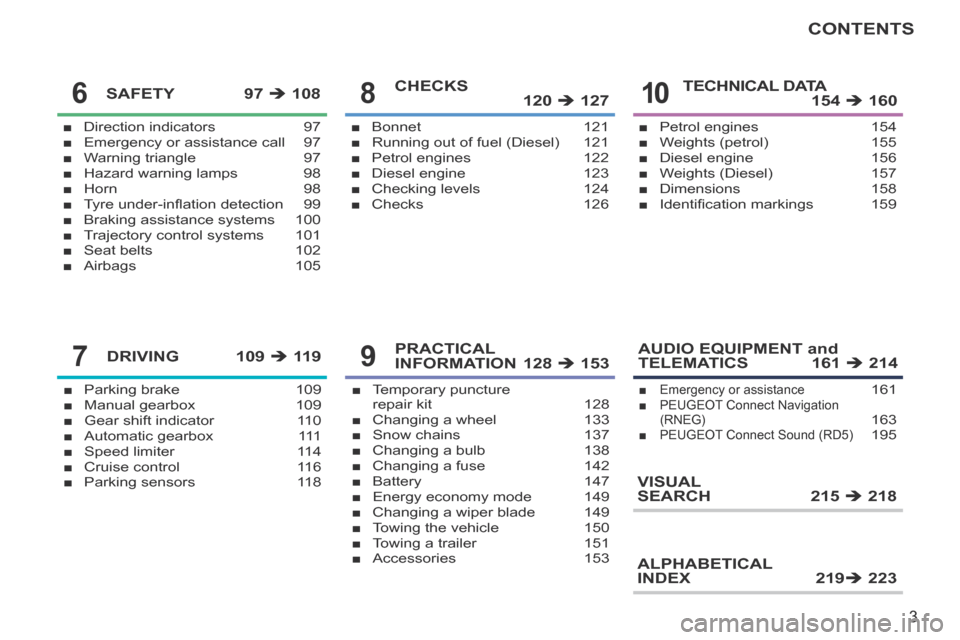
3
CONTENTS
207CC_EN_CHAP00A_SOMMAIRE_ED01-2014
■ Direction indicators 97
■ Emergency or assistance call 97
■ Warning triangle 97
■ Hazard warning lamps 98
■ Horn 98
■ Tyre under-infl ation detection 99
■ Braking assistance systems 100
■ Trajectory control systems 101
■ Seat belts 102
■ Airbags 105
SAFETY 97 108
■ Parking brake 109
■ Manual gearbox 109
■ Gear shift indicator 110
■ Automatic gearbox 111
■ Speed limiter 114
■ Cruise control 116
■ Parking sensors 118
DRIVING 109 11 9
■ Bonnet 121
■ Running out of fuel (Diesel) 121
■ Petrol engines 122
■ Diesel engine 123
■ Checking levels 124
■ Checks 126
CHECKS
120 127
■ Temporary puncture
repair kit 128
■ Changing a wheel 133
■ Snow chains 137
■ Changing a bulb 138
■ Changing a fuse 142
■ Battery 147
■ Energy economy mode 149
■ Changing a wiper blade 149
■ Towing the vehicle 150
■ Towing a trailer 151
■ Accessories 153
PRACTICAL
INFORMATION 128 153
■ Petrol engines 154
■ Weights (petrol) 155
■ Diesel engine 156
■ Weights (Diesel) 157
■ Dimensions 158
■ Identifi cation markings 159
TECHNICAL DATA 154 160
AUDIO EQUIPMENT and
TELEMATICS 161 214
■ Emergency or assistance 161
■ PEUGEOT Connect Navigation
(RNEG) 163
■ PEUGEOT Connect Sound (RD5) 195
ALPHABETICAL
INDEX 219 223
7
86
9
10
VISUAL
SEARCH 215 218
Page 48 of 232
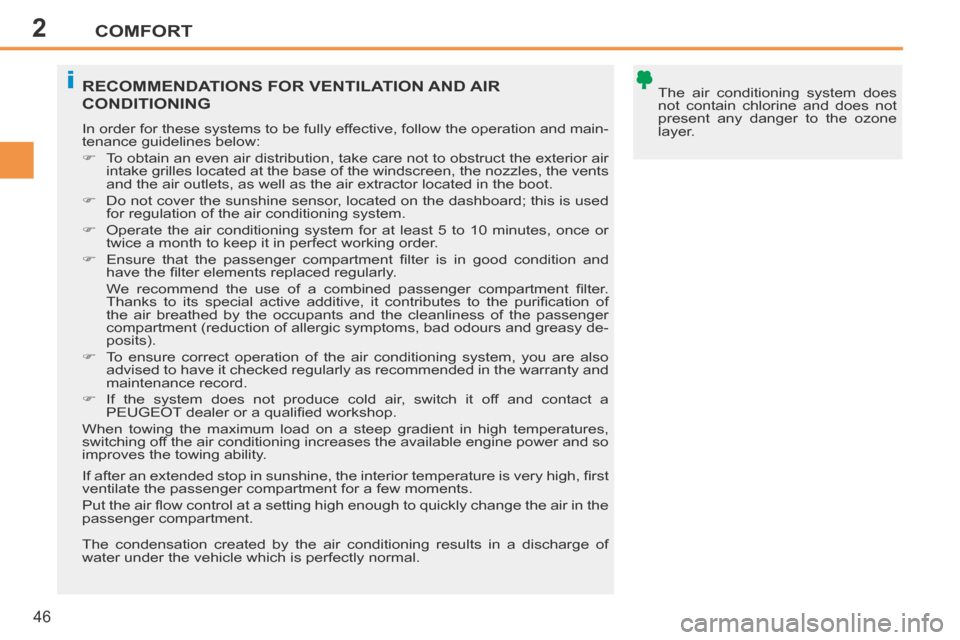
2
i
COMFORT
46
207CC_EN_CHAP02_CONFORT_ED01-2014
The air conditioning system does
not contain chlorine and does not
present any danger to the ozone
layer. RECOMMENDATIONS FOR VENTILATION AND AIR
CONDITIONING
In order for these systems to be fully effective, follow the operation and main-
tenance guidelines below:
To obtain an even air distribution, take care not to obstruct the exterio\
r air intake grilles located at the base of the windscreen, the nozzles, the v\
ents
and the air outlets, as well as the air extractor located in the boot.
Do not cover the sunshine sensor, located on the dashboard; this is used for regulation of the air conditioning system.
Operate the air conditioning system for at least 5 to 10 minutes, once o\
r twice a month to keep it in perfect working order.
Ensure that the passenger compartment fi lter is in good condition and have the fi lter elements replaced regularly.
We recommend the use of a combined passenger compartment fi lter. Thanks to its special active additive, it contributes to the purifi cation of
the air breathed by the occupants and the cleanliness of the passenger
compartment (reduction of allergic symptoms, bad odours and greasy de-
posits).
To ensure correct operation of the air conditioning system, you are also \
advised to have it checked regularly as recommended in the warranty and \
maintenance record.
If the system does not produce cold air, switch it off and contact a PEUGEOT dealer or a qualifi ed workshop.
When towing the maximum load on a steep gradient in high temperatures,
switching off the air conditioning increases the available engine power and so
improves the towing ability.
If after an extended stop in sunshine, the interior temperature is very high, fi rst
ventilate the passenger compartment for a few moments.
Put the air fl ow control at a setting high enough to quickly change the air in the
passenger compartment.
The condensation created by the air conditioning results in a discharge \
of
water under the vehicle which is perfectly normal.
Page 100 of 232
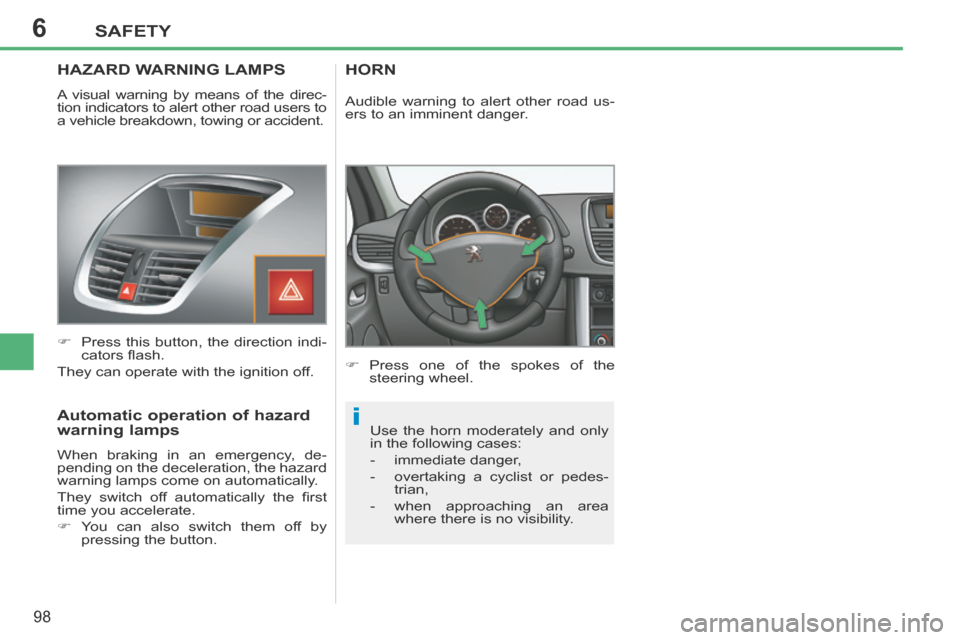
6
i
SAFETY
98
207CC_EN_CHAP06_SECURITE_ED01-2014
HAZARD WARNING LAMPS
A visual warning by means of the direc-
tion indicators to alert other road users to
a vehicle breakdown, towing or accident.
Press this button, the direction indi-cators fl ash.
They can operate with the ignition off.
Automatic operation of hazard
warning lamps
When braking in an emergency, de-
pending on the deceleration, the hazard
warning lamps come on automatically.
They switch off automatically the fi rst
time you accelerate.
You can also switch them off by pressing the button.
HORN
Press one of the spokes of the steering wheel.
Use the horn moderately and only
in the following cases:
- immediate danger,
- overtaking a cyclist or pedes- trian,
- when approaching an area where there is no visibility.
Audible warning to alert other road us-
ers to an imminent danger.
Page 135 of 232
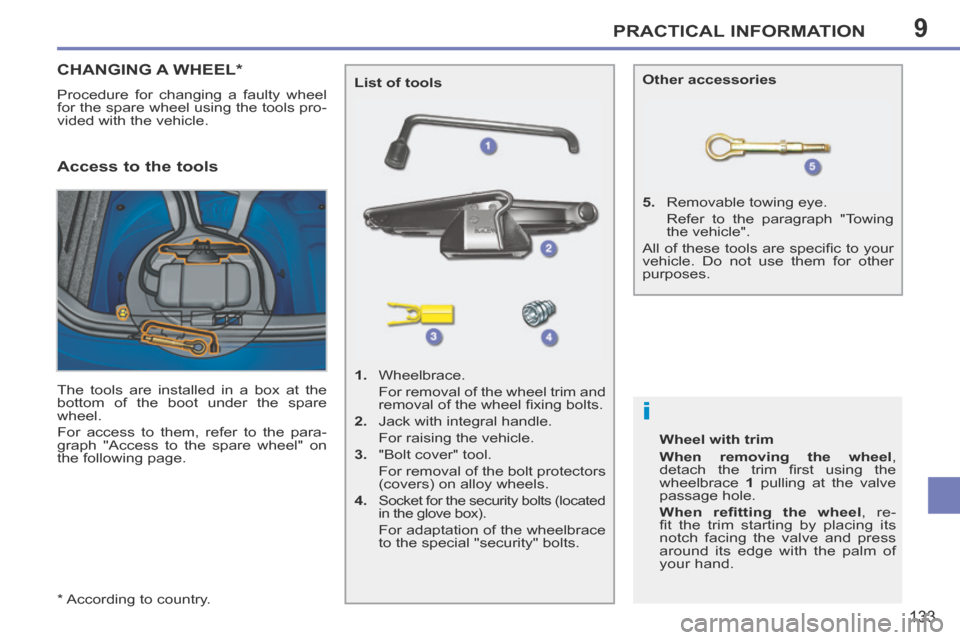
9
i
PRACTICAL INFORMATION
133
207CC_EN_CHAP09_INFO PRATIQUES_ED01-2014
* According to country.
CHANGING A WHEEL *
Procedure for changing a faulty wheel
for the spare wheel using the tools pro-
vided with the vehicle.
Access to the tools
The tools are installed in a box at the
bottom of the boot under the spare
wheel.
For access to them, refer to the para-
graph "Access to the spare wheel" on
the following page. List of tools
1. Wheelbrace.
For removal of the wheel trim and
removal of the wheel fi xing bolts.
2. Jack with integral handle.
For raising the vehicle.
3. "Bolt cover" tool.
For removal of the bolt protectors (covers) on alloy wheels.
4.
Socket for the security bolts (located
in the glove box).
For adaptation of the wheelbrace to the special "security" bolts. 5. Removable towing eye.
Refer to the paragraph "Towing the vehicle".
All of these tools are specifi c to your
vehicle. Do not use them for other
purposes.
Other accessories
Wheel with trim
When removing the wheel ,
detach the trim fi rst using the
wheelbrace 1 pulling at the valve
passage hole.
When refi tting the wheel , re-
fi t the trim starting by placing its
notch facing the valve and press
around its edge with the palm of
your hand.
Page 152 of 232
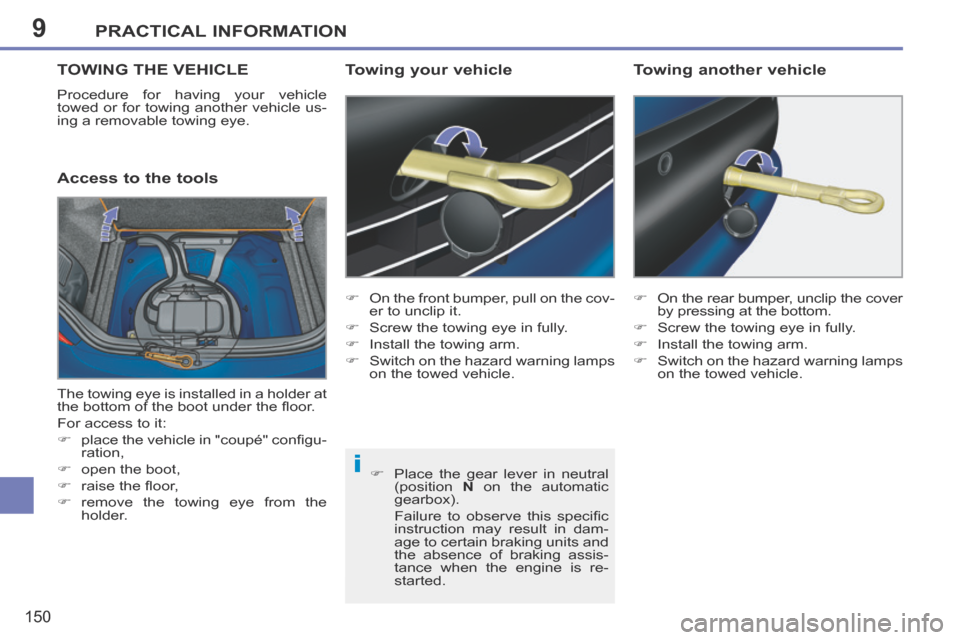
9
i
PRACTICAL INFORMATION
150
207CC_EN_CHAP09_INFO PRATIQUES_ED01-2014
TOWING THE VEHICLE
Procedure for having your vehicle
towed or for towing another vehicle us-
ing a removable towing eye.
Access to the tools
Towing your vehicle
On the front bumper, pull on the cov-er to unclip it.
Screw the towing eye in fully.
Install the towing arm.
Switch on the hazard warning lamps on the towed vehicle. On the rear bumper, unclip the cover
by pressing at the bottom.
Screw the towing eye in fully.
Install the towing arm.
Switch on the hazard warning lamps on the towed vehicle.
Towing another vehicle
The towing eye is installed in a holder at
the bottom of the boot under the fl oor.
For access to it:
place the vehicle in "coupé" confi gu-ration,
open the boot,
raise the fl oor,
remove the towing eye from the holder. Place the gear lever in neutral
(position N on the automatic
gearbox).
Failure to observe this specifi c instruction may result in dam-
age to certain braking units and
the absence of braking assis-
tance when the engine is re-
started.
Page 153 of 232
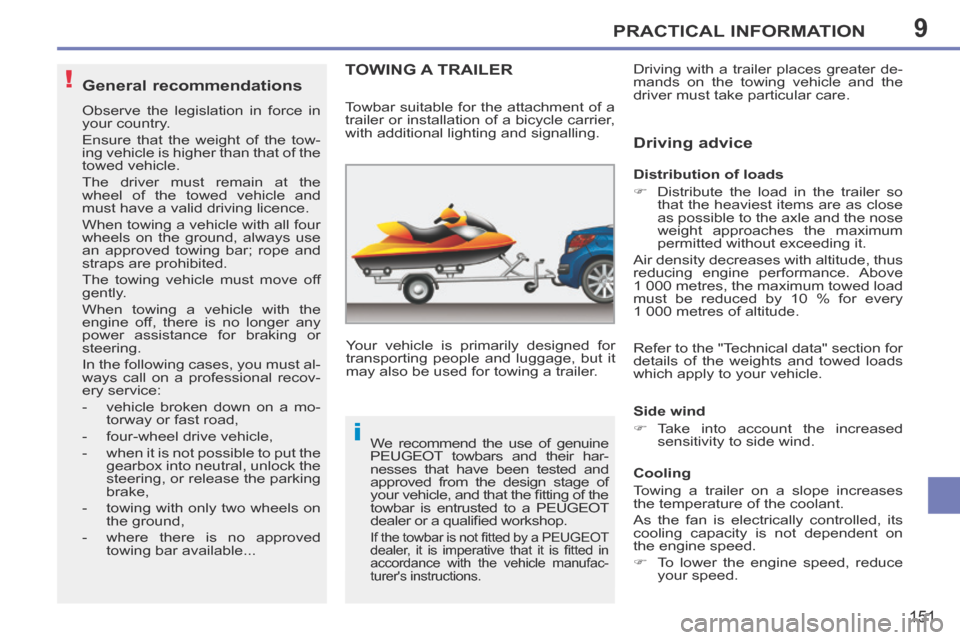
9
!
i
PRACTICAL INFORMATION
151
207CC_EN_CHAP09_INFO PRATIQUES_ED01-2014
General recommendations
Observe the legislation in force in
your country.
Ensure that the weight of the tow-
ing vehicle is higher than that of the
towed vehicle.
The driver must remain at the
wheel of the towed vehicle and
must have a valid driving licence.
When towing a vehicle with all four
wheels on the ground, always use
an approved towing bar; rope and
straps are prohibited.
The towing vehicle must move off
gently.
When towing a vehicle with the
engine off, there is no longer any
power assistance for braking or
steering.
In the following cases, you must al-
ways call on a professional recov-
ery service:
- vehicle broken down on a mo-torway or fast road,
- four-wheel drive vehicle,
- when it is not possible to put the gearbox into neutral, unlock the
steering, or release the parking
brake,
- towing with only two wheels on the ground,
- where there is no approved towing bar available...
TOWING A TRAILER
Your vehicle is primarily designed for
transporting people and luggage, but it
may also be used for towing a trailer. Driving with a trailer places greater de-
mands on the towing vehicle and the
driver must take particular care.
Distribution of loads
Distribute the load in the trailer so
that the heaviest items are as close
as possible to the axle and the nose
weight approaches the maximum
permitted without exceeding it.
Air density decreases with altitude, thus
reducing engine performance. Above
1 000 metres, the maximum towed load
must be reduced by 10 % for every
1 000 metres of altitude.
Side wind
Take into account the increased sensitivity to side wind.
Towbar suitable for the attachment of a
trailer or installation of a bicycle carrier,
with additional lighting and signalling.
We recommend the use of genuine
PEUGEOT towbars and their har-
nesses that have been tested and
approved from the design stage of
your vehicle, and that the fi tting of the
towbar is entrusted to a PEUGEOT
dealer or a qualifi ed workshop.
If the towbar is not fi tted by a PEUGEOT
dealer, it is imperative that it is fi tted in
accordance with the vehicle manufac-
turer's instructions.
Driving advice
Cooling
Towing a trailer on a slope increases
the temperature of the coolant.
As the fan is electrically controlled, its
cooling capacity is not dependent on
the engine speed.
To lower the engine speed, reduce your speed.
Refer to the "Technical data" section for
details of the weights and towed loads
which apply to your vehicle.
Page 154 of 232
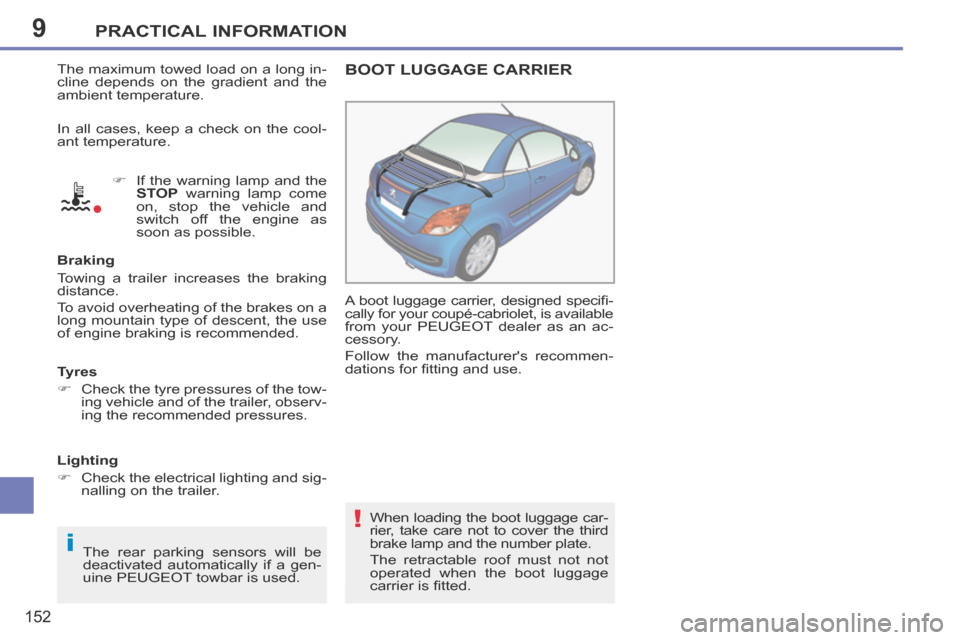
9
i
!
PRACTICAL INFORMATION
152
207CC_EN_CHAP09_INFO PRATIQUES_ED01-2014
The maximum towed load on a long in-
cline depends on the gradient and the
ambient temperature. If the warning lamp and the STOP warning lamp come
on, stop the vehicle and
switch off the engine as
soon as possible.
Braking
Towing a trailer increases the braking
distance.
To avoid overheating of the brakes on a
long mountain type of descent, the use
of engine braking is recommended.
Tyres
Check the tyre pressures of the tow- ing vehicle and of the trailer, observ-
ing the recommended pressures.
The rear parking sensors will be
deactivated automatically if a gen-
uine PEUGEOT towbar is used.
In all cases, keep a check on the cool-
ant temperature.
Lighting
Check the electrical lighting and sig-
nalling on the trailer. BOOT LUGGAGE CARRIER
A boot luggage carrier, designed specifi -
cally for your coupé-cabriolet, is available
from your PEUGEOT dealer as an ac-
cessory.
Follow the manufacturer's recommen-
dations for fi tting and use.
When loading the boot luggage car-
rier, take care not to cover the third
brake lamp and the number plate.
The retractable roof must not not
operated when the boot luggage
carrier is fi tted.
Page 157 of 232

10TECHNICAL DATA
155
207CC_EN_CHAP10_CARACTERISTIQUES_ED01-2014
The GTW and towed load values indicated apply up to a maximum altitude o\
f 1 000 metres; the towed load mentioned must
be reduced by 10 % for every additional 1 000 metres.
The speed of a towing vehicle must not exceed 60 mph (100 km/h) (comp\
ly with the legislation in force in your country).
High ambient temperatures may result in a reduction in the performance o\
f the vehicle to protect the engine; when the ambi-
ent temperature is higher than 37 °C, limit the towed weight. WEIGHTS AND TOWED LOADS (in kg)
Petrol engines 1.6 litre VTi 120 hp
Gearboxes Manual Auto.
- Unladen weight (kerb weight * ) 1 417 1 455
- Payload 292 312
- Gross vehicle weight (GVW) 1 709 1 767
- Gross train weight (GVW)
on a 12% gradient 2 559 2 647
- Braked trailer (within GTW limit)
on a 10% or 12% gradient - -
- Braked trailer ** (with load transfer within GTW limit) 1 040
1 060
- Unbraked trailer 600 600
- Recommended nose weight 42 43
* The kerb weight is equal to the unladen weight + driver (75 kg).
** The weight of the braked trailer can be increased, within the GTW limit,\
on condition that the GVW of the towing vehicle is re- duced by the same amount; warning: towing with a lightly loaded towing v\
ehicle may have an adverse effect on its road holding.
Page 159 of 232

10TECHNICAL DATA
157
207CC_EN_CHAP10_CARACTERISTIQUES_ED01-2014
The GTW and towed load values indicated apply up to a maximum altitude o\
f 1 000 metres; the towed load mentioned must
be reduced by 10 % for every additional 1 000 metres.
The speed of a towing vehicle must not exceed 60 mph (100 km/h) (comp\
ly with the legislation in force in your country).
High ambient temperatures may result in a reduction in the performance o\
f the vehicle to protect the engine; when the ambi-
ent temperature is higher than 37 °C, limit the towed weight. WEIGHTS AND TOWED LOADS (in kg)
Diesel engine 1.6 litre HDi 112 hp
Gearbox Manual
- Unladen weight (kerb weight * ) 1 475
- Payload 308
- Gross vehicle weight (GVW) 1 783
- Gross train weight (GTW)
on a 12% gradient 2 673
- Braked trailer (within GTW limit)
on a 10% or 12% gradient -
- Braked trailer ** (with load transfer within GTW limit) 1 070
- Unbraked trailer 600
- Recommended nose weight 43
* The kerb weight is equal to the unladen weight + driver (75 kg).
** The weight of the braked trailer can be increased, within the GTW limit,\
on condition that the GVW of the towing vehicle is re- duced by the same amount; warning: towing with a lightly loaded towing v\
ehicle may have an adverse effect on its road holding.
Page 217 of 232
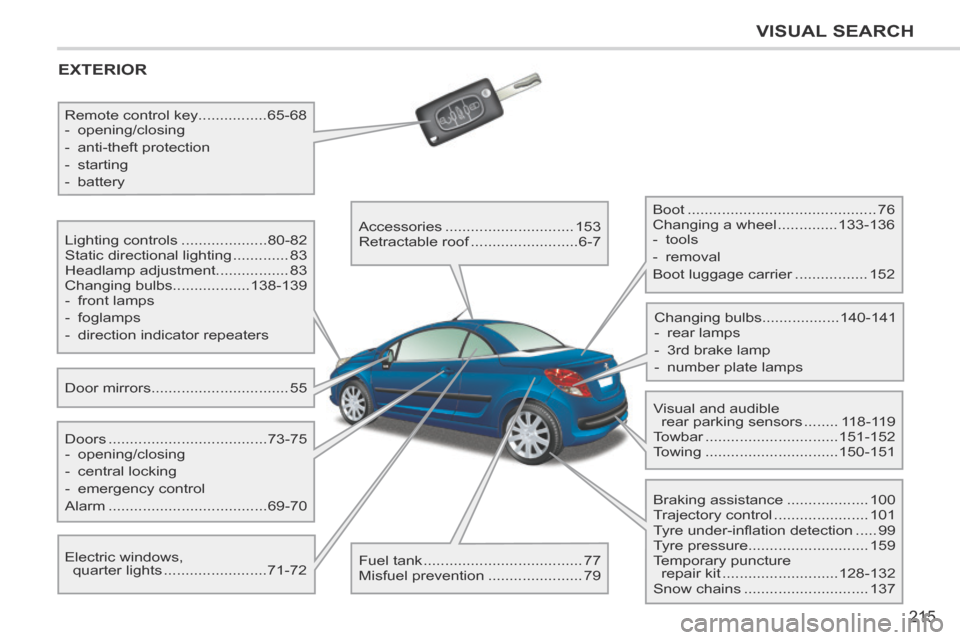
215
VISUAL SEARCH
207CC_EN_CHAP12_RECHERCHE VISUELLE_ED01-2014
EXTERIOR
Door mirrors ................................55
Lighting controls ....................
80-82
Static directional lighting ............. 83
Headlamp adjustment .................83
Changing bulbs ..................138-139
- front lamps
- foglamps
- direction indicator repeaters
Electric windows, quarter lights ........................ 71-72
Doors .....................................
73-75
- opening/closing
- central locking
- emergency control
Alarm ..................................... 69-70
Remote control key
................65-68
- opening/closing
- anti-theft protection
- starting
- battery
Accessories ..............................153
Retractable roof ......................... 6-7
Fuel tank ..................................... 77
Misfuel prevention ...................... 79 Boot ............................................
76
Changing a wheel .............. 133-136
- tools
- removal
Boot luggage carrier ................. 152
Visual and audible rear parking sensors ........ 118-119
Towbar ............................... 151-152
Towing ............................... 150-151
Changing bulbs
..................140-141
- rear lamps
- 3rd brake lamp
- number plate lamps
Braking assistance ................... 100
Trajectory control ...................... 101
Tyre under-infl ation detection ..... 99
Tyre pressure ............................ 159
Temporary puncture repair kit ........................... 128-132
Snow chains ............................. 137